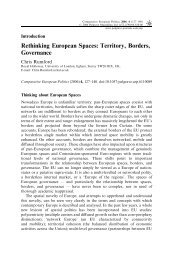Europeanisation, National Identities and Migration ... - europeanization
Europeanisation, National Identities and Migration ... - europeanization
Europeanisation, National Identities and Migration ... - europeanization
You also want an ePaper? Increase the reach of your titles
YUMPU automatically turns print PDFs into web optimized ePapers that Google loves.
11 Changing rhetoric <strong>and</strong><br />
narratives<br />
German trade unions <strong>and</strong> Polish<br />
migrant workers<br />
Norbert Cyrus<br />
<strong>Europeanisation</strong> <strong>and</strong> intermediary organisations<br />
<strong>Europeanisation</strong> – defined as ‘the emergence of new institutions, new types of social<br />
<strong>and</strong> political actions, <strong>and</strong> new forms of culture beyond or across national boundaries’<br />
– evidently ‘challenges bounded notions of state sovereignty; of state control<br />
over social process; <strong>and</strong> of state legitimacy over political membership <strong>and</strong><br />
participation’ (Favell 1998: 1). In the processes of <strong>Europeanisation</strong> the EU turns<br />
out to be both cause <strong>and</strong> effect of itself, a result of a ‘set of explosive <strong>and</strong> indeterminate<br />
effects of late-twentieth century social <strong>and</strong> political processes. These effects<br />
are fundamentally reorganising territoriality <strong>and</strong> peoplehood, the two principles<br />
that have shaped modern European borders’ (Borneman <strong>and</strong> Fowler 1997: 489).<br />
The hitherto nationally bounded construction <strong>and</strong> maintenance of boundaries<br />
of belonging withers away. Some research has been done on the construction of<br />
new European institutions <strong>and</strong> symbols (for a social anthropological review see<br />
Borneman <strong>and</strong> Fowler 1997) with a focus on the transnational policy arena <strong>and</strong> the<br />
impact of great actors. But European integration is not only a structural top-down<br />
re-arrangement of the institutional framework <strong>and</strong> national juridical provision. In<br />
the age of <strong>Europeanisation</strong>, actors have to adapt to the changing cultural l<strong>and</strong>scape<br />
which comes along with the institutional, political, social <strong>and</strong> cultural rearrangements<br />
from top-down. Surveys such as those by EUROSTAT report trends<br />
in the national public perception of European issues in member states but cannot<br />
supply insights as to how bottom-up adaptation is working. Until now, the social <strong>and</strong><br />
cultural process of bottom-up adaptation of Europe has been widely neglected.<br />
Following Knill <strong>and</strong> Lehmkuhl (1999) three ideal types of modes of<br />
<strong>Europeanisation</strong> can be distinguished: positive integration means the imposition of<br />
concrete institutional requirements with which member states must comply. Negative<br />
integration means that European legislation may affect the domestic arrangements by<br />
altering the domestic rules of the game, but do not prescribe any distinctive<br />
institutional model of how the new institutional equilibrium should actually look.<br />
Framing integration affects domestic arrangements more indirectly, namely by altering<br />
the beliefs <strong>and</strong> expectations of domestic actors. The changes in domestic beliefs may<br />
in turn affect the strategies <strong>and</strong> preferences of domestic actors, potentially leading<br />
to corresponding institutional adaptations. In other words: framing integration,



